CBCT in Endodontics: Advantages, Drawbacks, and Radiation Protection
VerifiedAdded on 2023/06/10
|16
|5097
|278
AI Summary
This article discusses the history of X-rays and CBCT, the effects of ionizing radiation, radiation protection, imaging in endodontics, CBCT application in endodontics, advantages and drawbacks of CBCT, and CBCT training. It provides information on the necessary training for endodontists and radiation protection guidelines.
Contribute Materials
Your contribution can guide someone’s learning journey. Share your
documents today.

Running head: DENTISTRY
Dentistry
Name of the Student
Name of the University
Author Note
Dentistry
Name of the Student
Name of the University
Author Note
Secure Best Marks with AI Grader
Need help grading? Try our AI Grader for instant feedback on your assignments.

1DENTISTRY
History of X-rays and CBCT
This section will comprise of a review of scholarly articles that encompass current
theoretical and methodological knowledge on substantive research findings, which in turn
will contribute to the topic of interest. The section will discuss published information relevant
to the two research aims, in an organized pattern by summarizing the pertinent findings. The
first aim of the research is to investigate whether the endodontists undertaking the CBCT
scans follow the justification criteria that are set out by the AAE ESE position statement.
Radiography refers to the imaging technique that depends on the use of x-rays for viewing
the internal forms of a biological object. The process of radiography encompasses creation
of a beam of electromagnetic radiation, or x-rays that are produced from a generator and
projected towards the object, currently being viewed. The discovery of x-rays is credited to
Wilhelm Röntgen, the German physicist, who was the first person to systematically conduct
a study on its functions. X-rays were found to get emanated from discharge tubes,
commonly known as Crookes tubes, which produced free electrons by residual air ionization.
Radiological cars were developed in 1914 for supporting the soldiers injured during World
War 1. A new invention, commonly known as computed tomography was developed in the
year 1972 that brought about major transformation in diagnostic medicine. No significant
changes were observed in geometry for imaging dentition since 1896. CBCT or cone beam
technology, the medical technique based on x-ray computed tomography has gained
attention in the treatment, planning and diagnosis of implant dentistry. This technique was
introduced in 1996 in Europe by QR s.r.l. (NewTom 9000) and in 2001 in the US market. The
role of CBCT in implant radiography can be attributed to the fact that the dental cone beam
has the property of offering valuable information regarding the planning and assessment of
surgical implants and is now one of the most preferred options of pre-surgical dental implant
assessments (Bornstein et al. 2014). The technique also has the capability of presenting
undistorted views of dentition that are accurately used for visualising non-erupted and
erupted teeth, and tooth roots that cannot be viewed by 2-d radiography.
History of X-rays and CBCT
This section will comprise of a review of scholarly articles that encompass current
theoretical and methodological knowledge on substantive research findings, which in turn
will contribute to the topic of interest. The section will discuss published information relevant
to the two research aims, in an organized pattern by summarizing the pertinent findings. The
first aim of the research is to investigate whether the endodontists undertaking the CBCT
scans follow the justification criteria that are set out by the AAE ESE position statement.
Radiography refers to the imaging technique that depends on the use of x-rays for viewing
the internal forms of a biological object. The process of radiography encompasses creation
of a beam of electromagnetic radiation, or x-rays that are produced from a generator and
projected towards the object, currently being viewed. The discovery of x-rays is credited to
Wilhelm Röntgen, the German physicist, who was the first person to systematically conduct
a study on its functions. X-rays were found to get emanated from discharge tubes,
commonly known as Crookes tubes, which produced free electrons by residual air ionization.
Radiological cars were developed in 1914 for supporting the soldiers injured during World
War 1. A new invention, commonly known as computed tomography was developed in the
year 1972 that brought about major transformation in diagnostic medicine. No significant
changes were observed in geometry for imaging dentition since 1896. CBCT or cone beam
technology, the medical technique based on x-ray computed tomography has gained
attention in the treatment, planning and diagnosis of implant dentistry. This technique was
introduced in 1996 in Europe by QR s.r.l. (NewTom 9000) and in 2001 in the US market. The
role of CBCT in implant radiography can be attributed to the fact that the dental cone beam
has the property of offering valuable information regarding the planning and assessment of
surgical implants and is now one of the most preferred options of pre-surgical dental implant
assessments (Bornstein et al. 2014). The technique also has the capability of presenting
undistorted views of dentition that are accurately used for visualising non-erupted and
erupted teeth, and tooth roots that cannot be viewed by 2-d radiography.
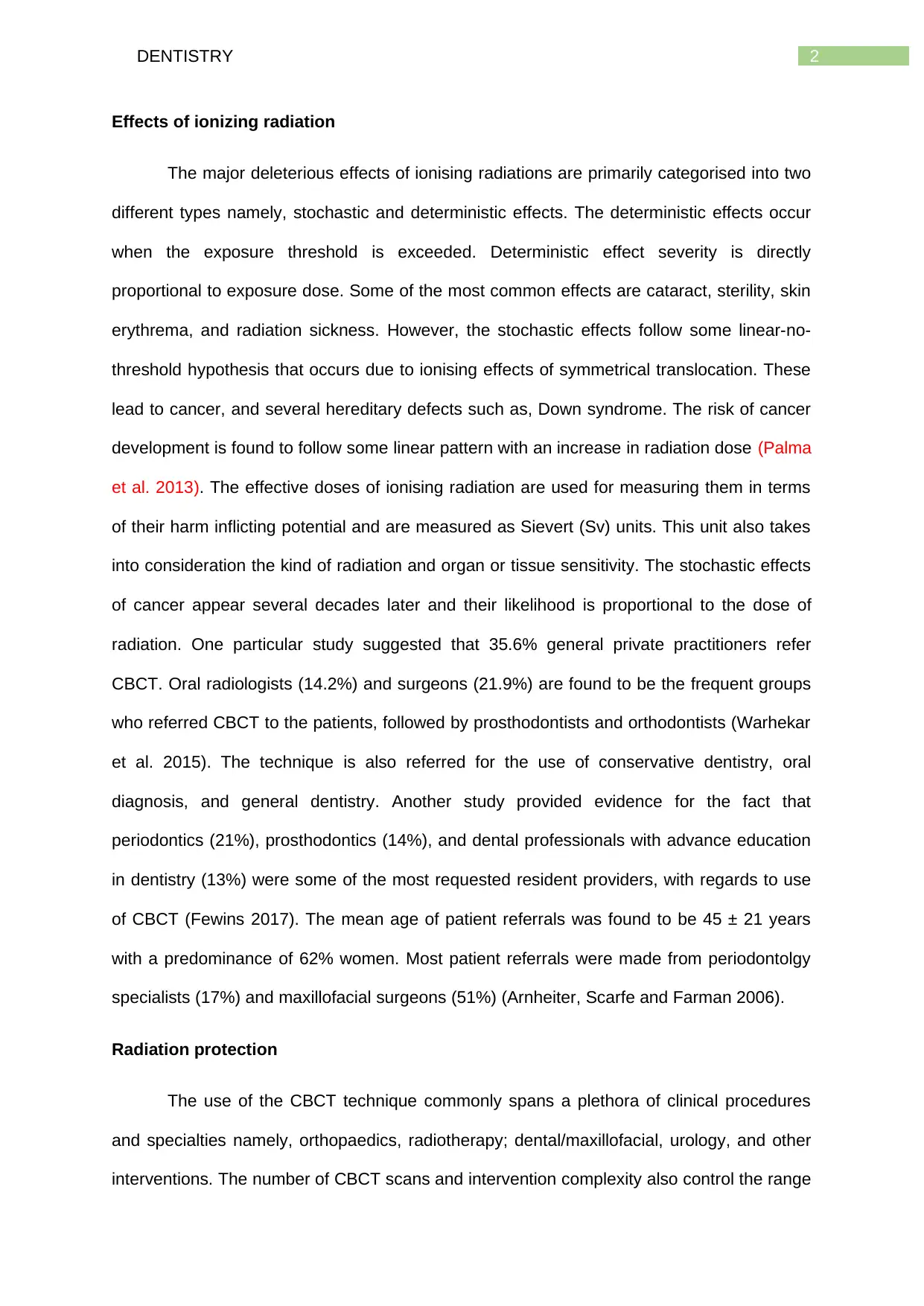
2DENTISTRY
Effects of ionizing radiation
The major deleterious effects of ionising radiations are primarily categorised into two
different types namely, stochastic and deterministic effects. The deterministic effects occur
when the exposure threshold is exceeded. Deterministic effect severity is directly
proportional to exposure dose. Some of the most common effects are cataract, sterility, skin
erythrema, and radiation sickness. However, the stochastic effects follow some linear-no-
threshold hypothesis that occurs due to ionising effects of symmetrical translocation. These
lead to cancer, and several hereditary defects such as, Down syndrome. The risk of cancer
development is found to follow some linear pattern with an increase in radiation dose (Palma
et al. 2013). The effective doses of ionising radiation are used for measuring them in terms
of their harm inflicting potential and are measured as Sievert (Sv) units. This unit also takes
into consideration the kind of radiation and organ or tissue sensitivity. The stochastic effects
of cancer appear several decades later and their likelihood is proportional to the dose of
radiation. One particular study suggested that 35.6% general private practitioners refer
CBCT. Oral radiologists (14.2%) and surgeons (21.9%) are found to be the frequent groups
who referred CBCT to the patients, followed by prosthodontists and orthodontists (Warhekar
et al. 2015). The technique is also referred for the use of conservative dentistry, oral
diagnosis, and general dentistry. Another study provided evidence for the fact that
periodontics (21%), prosthodontics (14%), and dental professionals with advance education
in dentistry (13%) were some of the most requested resident providers, with regards to use
of CBCT (Fewins 2017). The mean age of patient referrals was found to be 45 ± 21 years
with a predominance of 62% women. Most patient referrals were made from periodontolgy
specialists (17%) and maxillofacial surgeons (51%) (Arnheiter, Scarfe and Farman 2006).
Radiation protection
The use of the CBCT technique commonly spans a plethora of clinical procedures
and specialties namely, orthopaedics, radiotherapy; dental/maxillofacial, urology, and other
interventions. The number of CBCT scans and intervention complexity also control the range
Effects of ionizing radiation
The major deleterious effects of ionising radiations are primarily categorised into two
different types namely, stochastic and deterministic effects. The deterministic effects occur
when the exposure threshold is exceeded. Deterministic effect severity is directly
proportional to exposure dose. Some of the most common effects are cataract, sterility, skin
erythrema, and radiation sickness. However, the stochastic effects follow some linear-no-
threshold hypothesis that occurs due to ionising effects of symmetrical translocation. These
lead to cancer, and several hereditary defects such as, Down syndrome. The risk of cancer
development is found to follow some linear pattern with an increase in radiation dose (Palma
et al. 2013). The effective doses of ionising radiation are used for measuring them in terms
of their harm inflicting potential and are measured as Sievert (Sv) units. This unit also takes
into consideration the kind of radiation and organ or tissue sensitivity. The stochastic effects
of cancer appear several decades later and their likelihood is proportional to the dose of
radiation. One particular study suggested that 35.6% general private practitioners refer
CBCT. Oral radiologists (14.2%) and surgeons (21.9%) are found to be the frequent groups
who referred CBCT to the patients, followed by prosthodontists and orthodontists (Warhekar
et al. 2015). The technique is also referred for the use of conservative dentistry, oral
diagnosis, and general dentistry. Another study provided evidence for the fact that
periodontics (21%), prosthodontics (14%), and dental professionals with advance education
in dentistry (13%) were some of the most requested resident providers, with regards to use
of CBCT (Fewins 2017). The mean age of patient referrals was found to be 45 ± 21 years
with a predominance of 62% women. Most patient referrals were made from periodontolgy
specialists (17%) and maxillofacial surgeons (51%) (Arnheiter, Scarfe and Farman 2006).
Radiation protection
The use of the CBCT technique commonly spans a plethora of clinical procedures
and specialties namely, orthopaedics, radiotherapy; dental/maxillofacial, urology, and other
interventions. The number of CBCT scans and intervention complexity also control the range
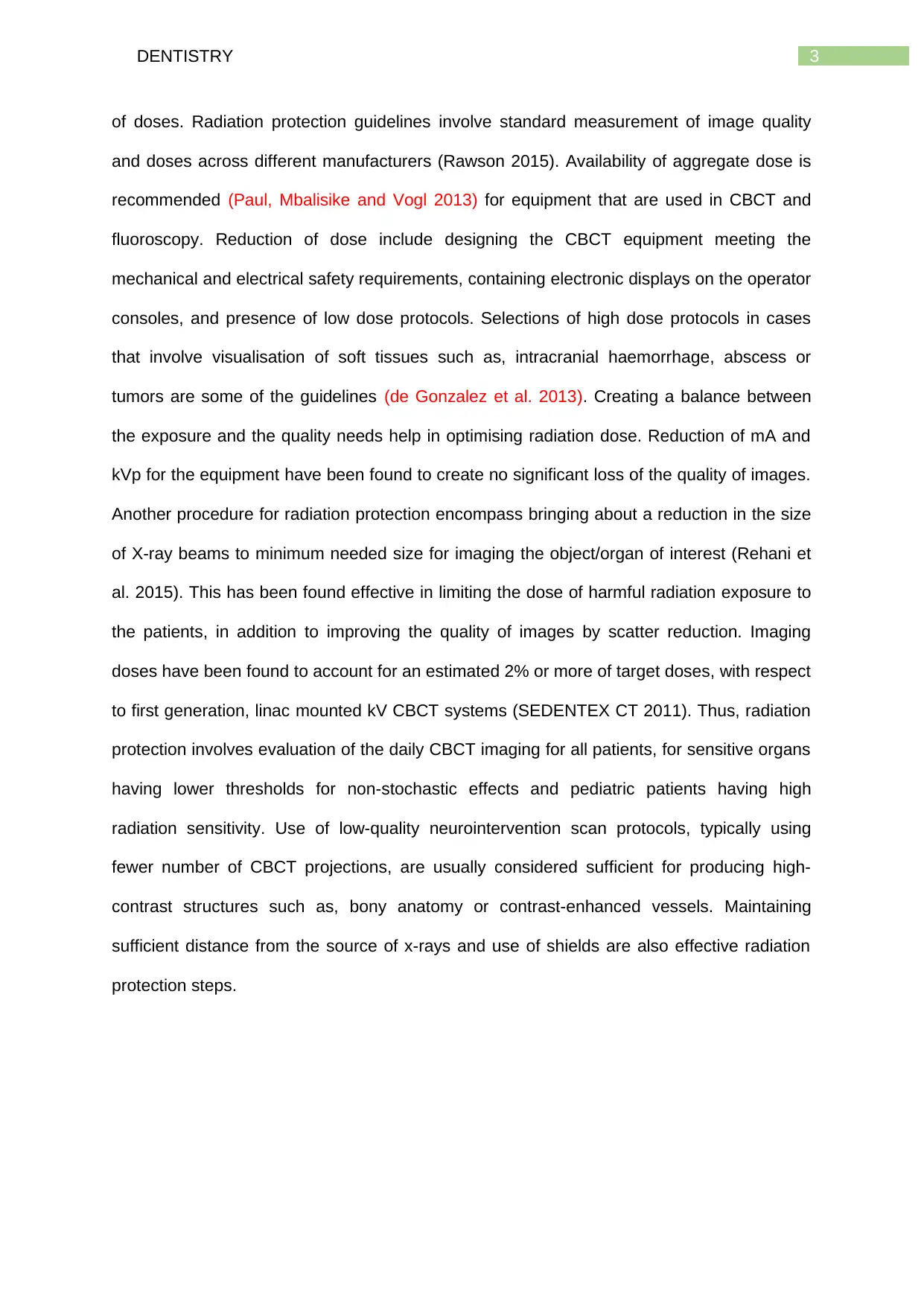
3DENTISTRY
of doses. Radiation protection guidelines involve standard measurement of image quality
and doses across different manufacturers (Rawson 2015). Availability of aggregate dose is
recommended (Paul, Mbalisike and Vogl 2013) for equipment that are used in CBCT and
fluoroscopy. Reduction of dose include designing the CBCT equipment meeting the
mechanical and electrical safety requirements, containing electronic displays on the operator
consoles, and presence of low dose protocols. Selections of high dose protocols in cases
that involve visualisation of soft tissues such as, intracranial haemorrhage, abscess or
tumors are some of the guidelines (de Gonzalez et al. 2013). Creating a balance between
the exposure and the quality needs help in optimising radiation dose. Reduction of mA and
kVp for the equipment have been found to create no significant loss of the quality of images.
Another procedure for radiation protection encompass bringing about a reduction in the size
of X-ray beams to minimum needed size for imaging the object/organ of interest (Rehani et
al. 2015). This has been found effective in limiting the dose of harmful radiation exposure to
the patients, in addition to improving the quality of images by scatter reduction. Imaging
doses have been found to account for an estimated 2% or more of target doses, with respect
to first generation, linac mounted kV CBCT systems (SEDENTEX CT 2011). Thus, radiation
protection involves evaluation of the daily CBCT imaging for all patients, for sensitive organs
having lower thresholds for non-stochastic effects and pediatric patients having high
radiation sensitivity. Use of low-quality neurointervention scan protocols, typically using
fewer number of CBCT projections, are usually considered sufficient for producing high-
contrast structures such as, bony anatomy or contrast-enhanced vessels. Maintaining
sufficient distance from the source of x-rays and use of shields are also effective radiation
protection steps.
of doses. Radiation protection guidelines involve standard measurement of image quality
and doses across different manufacturers (Rawson 2015). Availability of aggregate dose is
recommended (Paul, Mbalisike and Vogl 2013) for equipment that are used in CBCT and
fluoroscopy. Reduction of dose include designing the CBCT equipment meeting the
mechanical and electrical safety requirements, containing electronic displays on the operator
consoles, and presence of low dose protocols. Selections of high dose protocols in cases
that involve visualisation of soft tissues such as, intracranial haemorrhage, abscess or
tumors are some of the guidelines (de Gonzalez et al. 2013). Creating a balance between
the exposure and the quality needs help in optimising radiation dose. Reduction of mA and
kVp for the equipment have been found to create no significant loss of the quality of images.
Another procedure for radiation protection encompass bringing about a reduction in the size
of X-ray beams to minimum needed size for imaging the object/organ of interest (Rehani et
al. 2015). This has been found effective in limiting the dose of harmful radiation exposure to
the patients, in addition to improving the quality of images by scatter reduction. Imaging
doses have been found to account for an estimated 2% or more of target doses, with respect
to first generation, linac mounted kV CBCT systems (SEDENTEX CT 2011). Thus, radiation
protection involves evaluation of the daily CBCT imaging for all patients, for sensitive organs
having lower thresholds for non-stochastic effects and pediatric patients having high
radiation sensitivity. Use of low-quality neurointervention scan protocols, typically using
fewer number of CBCT projections, are usually considered sufficient for producing high-
contrast structures such as, bony anatomy or contrast-enhanced vessels. Maintaining
sufficient distance from the source of x-rays and use of shields are also effective radiation
protection steps.
Secure Best Marks with AI Grader
Need help grading? Try our AI Grader for instant feedback on your assignments.
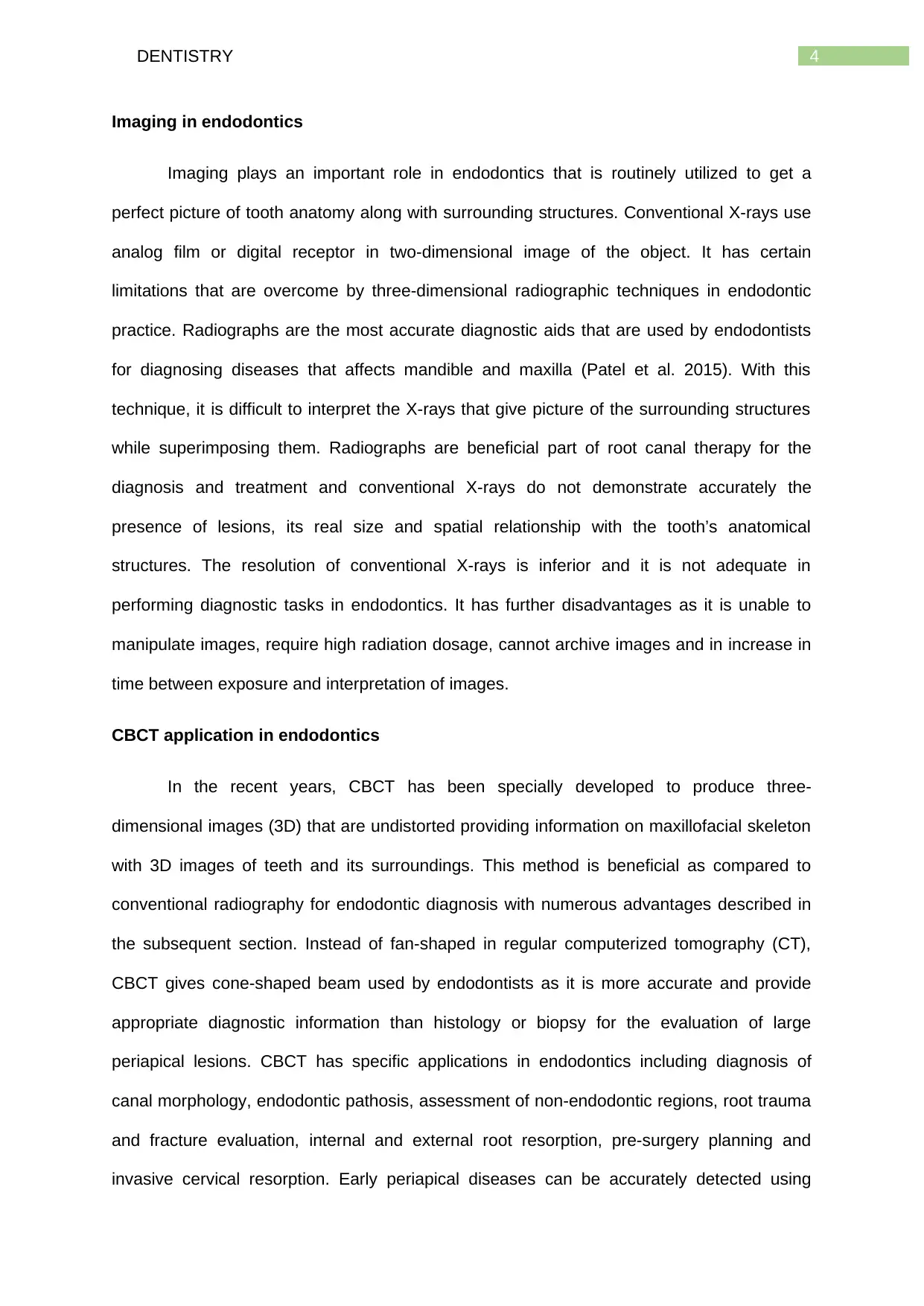
4DENTISTRY
Imaging in endodontics
Imaging plays an important role in endodontics that is routinely utilized to get a
perfect picture of tooth anatomy along with surrounding structures. Conventional X-rays use
analog film or digital receptor in two-dimensional image of the object. It has certain
limitations that are overcome by three-dimensional radiographic techniques in endodontic
practice. Radiographs are the most accurate diagnostic aids that are used by endodontists
for diagnosing diseases that affects mandible and maxilla (Patel et al. 2015). With this
technique, it is difficult to interpret the X-rays that give picture of the surrounding structures
while superimposing them. Radiographs are beneficial part of root canal therapy for the
diagnosis and treatment and conventional X-rays do not demonstrate accurately the
presence of lesions, its real size and spatial relationship with the tooth’s anatomical
structures. The resolution of conventional X-rays is inferior and it is not adequate in
performing diagnostic tasks in endodontics. It has further disadvantages as it is unable to
manipulate images, require high radiation dosage, cannot archive images and in increase in
time between exposure and interpretation of images.
CBCT application in endodontics
In the recent years, CBCT has been specially developed to produce three-
dimensional images (3D) that are undistorted providing information on maxillofacial skeleton
with 3D images of teeth and its surroundings. This method is beneficial as compared to
conventional radiography for endodontic diagnosis with numerous advantages described in
the subsequent section. Instead of fan-shaped in regular computerized tomography (CT),
CBCT gives cone-shaped beam used by endodontists as it is more accurate and provide
appropriate diagnostic information than histology or biopsy for the evaluation of large
periapical lesions. CBCT has specific applications in endodontics including diagnosis of
canal morphology, endodontic pathosis, assessment of non-endodontic regions, root trauma
and fracture evaluation, internal and external root resorption, pre-surgery planning and
invasive cervical resorption. Early periapical diseases can be accurately detected using
Imaging in endodontics
Imaging plays an important role in endodontics that is routinely utilized to get a
perfect picture of tooth anatomy along with surrounding structures. Conventional X-rays use
analog film or digital receptor in two-dimensional image of the object. It has certain
limitations that are overcome by three-dimensional radiographic techniques in endodontic
practice. Radiographs are the most accurate diagnostic aids that are used by endodontists
for diagnosing diseases that affects mandible and maxilla (Patel et al. 2015). With this
technique, it is difficult to interpret the X-rays that give picture of the surrounding structures
while superimposing them. Radiographs are beneficial part of root canal therapy for the
diagnosis and treatment and conventional X-rays do not demonstrate accurately the
presence of lesions, its real size and spatial relationship with the tooth’s anatomical
structures. The resolution of conventional X-rays is inferior and it is not adequate in
performing diagnostic tasks in endodontics. It has further disadvantages as it is unable to
manipulate images, require high radiation dosage, cannot archive images and in increase in
time between exposure and interpretation of images.
CBCT application in endodontics
In the recent years, CBCT has been specially developed to produce three-
dimensional images (3D) that are undistorted providing information on maxillofacial skeleton
with 3D images of teeth and its surroundings. This method is beneficial as compared to
conventional radiography for endodontic diagnosis with numerous advantages described in
the subsequent section. Instead of fan-shaped in regular computerized tomography (CT),
CBCT gives cone-shaped beam used by endodontists as it is more accurate and provide
appropriate diagnostic information than histology or biopsy for the evaluation of large
periapical lesions. CBCT has specific applications in endodontics including diagnosis of
canal morphology, endodontic pathosis, assessment of non-endodontic regions, root trauma
and fracture evaluation, internal and external root resorption, pre-surgery planning and
invasive cervical resorption. Early periapical diseases can be accurately detected using
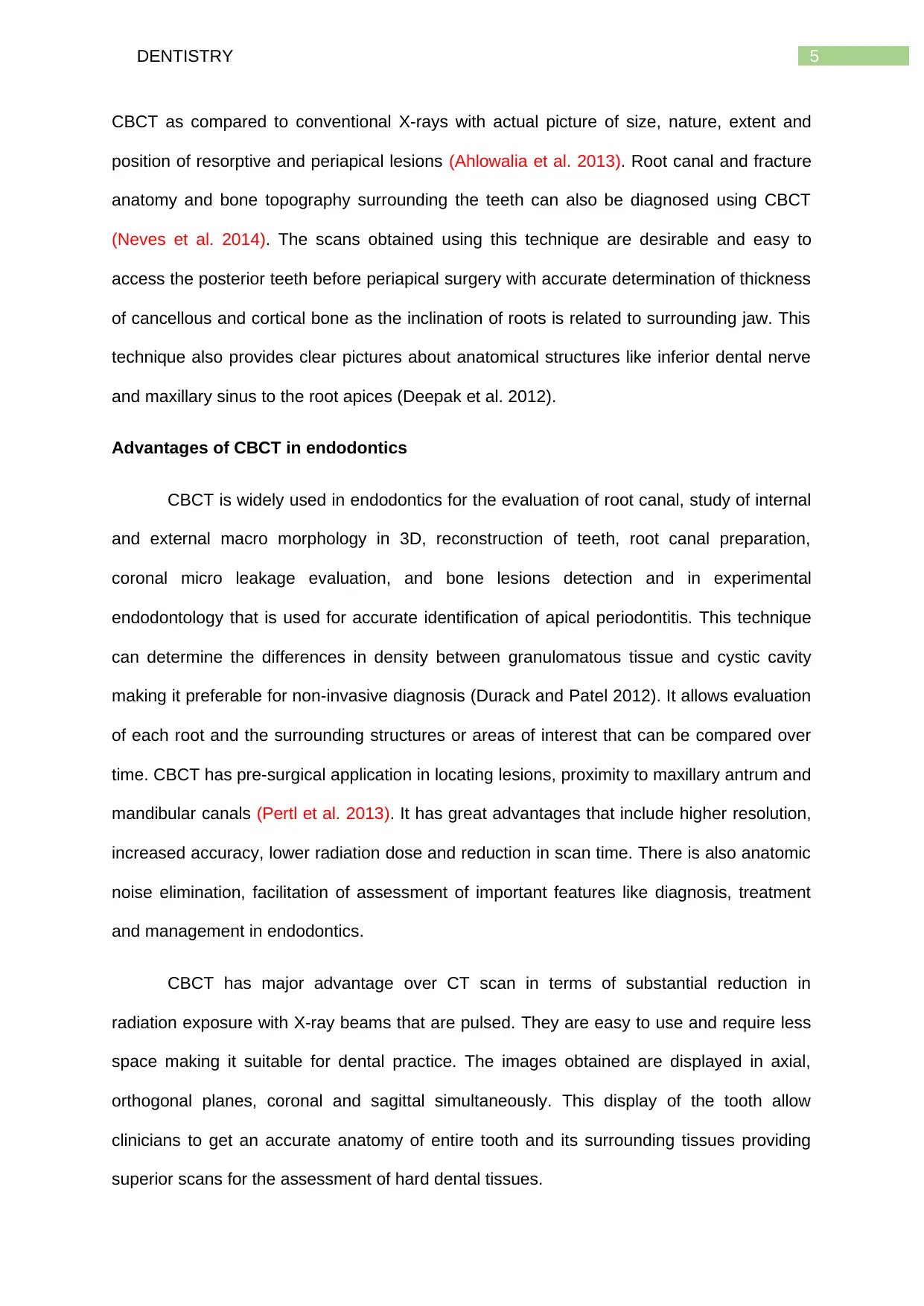
5DENTISTRY
CBCT as compared to conventional X-rays with actual picture of size, nature, extent and
position of resorptive and periapical lesions (Ahlowalia et al. 2013). Root canal and fracture
anatomy and bone topography surrounding the teeth can also be diagnosed using CBCT
(Neves et al. 2014). The scans obtained using this technique are desirable and easy to
access the posterior teeth before periapical surgery with accurate determination of thickness
of cancellous and cortical bone as the inclination of roots is related to surrounding jaw. This
technique also provides clear pictures about anatomical structures like inferior dental nerve
and maxillary sinus to the root apices (Deepak et al. 2012).
Advantages of CBCT in endodontics
CBCT is widely used in endodontics for the evaluation of root canal, study of internal
and external macro morphology in 3D, reconstruction of teeth, root canal preparation,
coronal micro leakage evaluation, and bone lesions detection and in experimental
endodontology that is used for accurate identification of apical periodontitis. This technique
can determine the differences in density between granulomatous tissue and cystic cavity
making it preferable for non-invasive diagnosis (Durack and Patel 2012). It allows evaluation
of each root and the surrounding structures or areas of interest that can be compared over
time. CBCT has pre-surgical application in locating lesions, proximity to maxillary antrum and
mandibular canals (Pertl et al. 2013). It has great advantages that include higher resolution,
increased accuracy, lower radiation dose and reduction in scan time. There is also anatomic
noise elimination, facilitation of assessment of important features like diagnosis, treatment
and management in endodontics.
CBCT has major advantage over CT scan in terms of substantial reduction in
radiation exposure with X-ray beams that are pulsed. They are easy to use and require less
space making it suitable for dental practice. The images obtained are displayed in axial,
orthogonal planes, coronal and sagittal simultaneously. This display of the tooth allow
clinicians to get an accurate anatomy of entire tooth and its surrounding tissues providing
superior scans for the assessment of hard dental tissues.
CBCT as compared to conventional X-rays with actual picture of size, nature, extent and
position of resorptive and periapical lesions (Ahlowalia et al. 2013). Root canal and fracture
anatomy and bone topography surrounding the teeth can also be diagnosed using CBCT
(Neves et al. 2014). The scans obtained using this technique are desirable and easy to
access the posterior teeth before periapical surgery with accurate determination of thickness
of cancellous and cortical bone as the inclination of roots is related to surrounding jaw. This
technique also provides clear pictures about anatomical structures like inferior dental nerve
and maxillary sinus to the root apices (Deepak et al. 2012).
Advantages of CBCT in endodontics
CBCT is widely used in endodontics for the evaluation of root canal, study of internal
and external macro morphology in 3D, reconstruction of teeth, root canal preparation,
coronal micro leakage evaluation, and bone lesions detection and in experimental
endodontology that is used for accurate identification of apical periodontitis. This technique
can determine the differences in density between granulomatous tissue and cystic cavity
making it preferable for non-invasive diagnosis (Durack and Patel 2012). It allows evaluation
of each root and the surrounding structures or areas of interest that can be compared over
time. CBCT has pre-surgical application in locating lesions, proximity to maxillary antrum and
mandibular canals (Pertl et al. 2013). It has great advantages that include higher resolution,
increased accuracy, lower radiation dose and reduction in scan time. There is also anatomic
noise elimination, facilitation of assessment of important features like diagnosis, treatment
and management in endodontics.
CBCT has major advantage over CT scan in terms of substantial reduction in
radiation exposure with X-ray beams that are pulsed. They are easy to use and require less
space making it suitable for dental practice. The images obtained are displayed in axial,
orthogonal planes, coronal and sagittal simultaneously. This display of the tooth allow
clinicians to get an accurate anatomy of entire tooth and its surrounding tissues providing
superior scans for the assessment of hard dental tissues.

6DENTISTRY
Drawbacks of CBCT
Although, CBCT overcome various limitations of conventional radiography, the
images produced by this technique have some significant problem. It affects the quality of
image in terms of diagnostic accuracy as the CBCT beam is scattering and hard due to high-
density structures in the surrounding like metallic posts, enamel and restorations, diagnostic
value lowering of root-canal perforations and internal root resorption. It is suggested that
CBCT should be combined with periapical radiographs for producing accurate pictures of
tooth and its surrounding tissues (Patel et al. 2013). In addition, scan times in CBCT are
lengthy having 15-20 seconds that requires patients to stay still during the procedure (Gümrü
and Tarçın 2013).
CBCT training
Although, ionizing radiation in CBCT use is not without risk, therefore endodontists
need to follow guidelines before administration. It is critical for them to take precautions to
keep the radiation exposure minimum for the patient. Moreover, every endodontic image
should be prescribed individually, where benefits outweigh potential risks associated with the
technique use. CBCT use in every day practice raises concerns for the endodontic
practitioners regarding necessary training and experience in order to take and evaluate
CBCT scans efficiently. This is a major diagnostic challenge among endodontists that
demand comprehensive knowledge and skills to master the technical operation as well as
understand the radiographic features of neck and head anatomy, pathology and technique
use that is beyond the experiences of endodontic practitioners (Kamburoğlu, Tsesis and
Rosen 2017). Many practitioners provide information to patients regarding CBCT imaging
from the perspective of technology assessment position like 3D image instead of 2D.
However, there is existence of fundamental distinction where they need to determine the
overall benefits of the imaging and its relation to the specific patient outcomes. The
practitioners should be accountable for their actions in CBCT use, as they need to exercise
judgment about various aspects of ethical, moral and legal regulations like patient safety.
Drawbacks of CBCT
Although, CBCT overcome various limitations of conventional radiography, the
images produced by this technique have some significant problem. It affects the quality of
image in terms of diagnostic accuracy as the CBCT beam is scattering and hard due to high-
density structures in the surrounding like metallic posts, enamel and restorations, diagnostic
value lowering of root-canal perforations and internal root resorption. It is suggested that
CBCT should be combined with periapical radiographs for producing accurate pictures of
tooth and its surrounding tissues (Patel et al. 2013). In addition, scan times in CBCT are
lengthy having 15-20 seconds that requires patients to stay still during the procedure (Gümrü
and Tarçın 2013).
CBCT training
Although, ionizing radiation in CBCT use is not without risk, therefore endodontists
need to follow guidelines before administration. It is critical for them to take precautions to
keep the radiation exposure minimum for the patient. Moreover, every endodontic image
should be prescribed individually, where benefits outweigh potential risks associated with the
technique use. CBCT use in every day practice raises concerns for the endodontic
practitioners regarding necessary training and experience in order to take and evaluate
CBCT scans efficiently. This is a major diagnostic challenge among endodontists that
demand comprehensive knowledge and skills to master the technical operation as well as
understand the radiographic features of neck and head anatomy, pathology and technique
use that is beyond the experiences of endodontic practitioners (Kamburoğlu, Tsesis and
Rosen 2017). Many practitioners provide information to patients regarding CBCT imaging
from the perspective of technology assessment position like 3D image instead of 2D.
However, there is existence of fundamental distinction where they need to determine the
overall benefits of the imaging and its relation to the specific patient outcomes. The
practitioners should be accountable for their actions in CBCT use, as they need to exercise
judgment about various aspects of ethical, moral and legal regulations like patient safety.
Paraphrase This Document
Need a fresh take? Get an instant paraphrase of this document with our AI Paraphraser
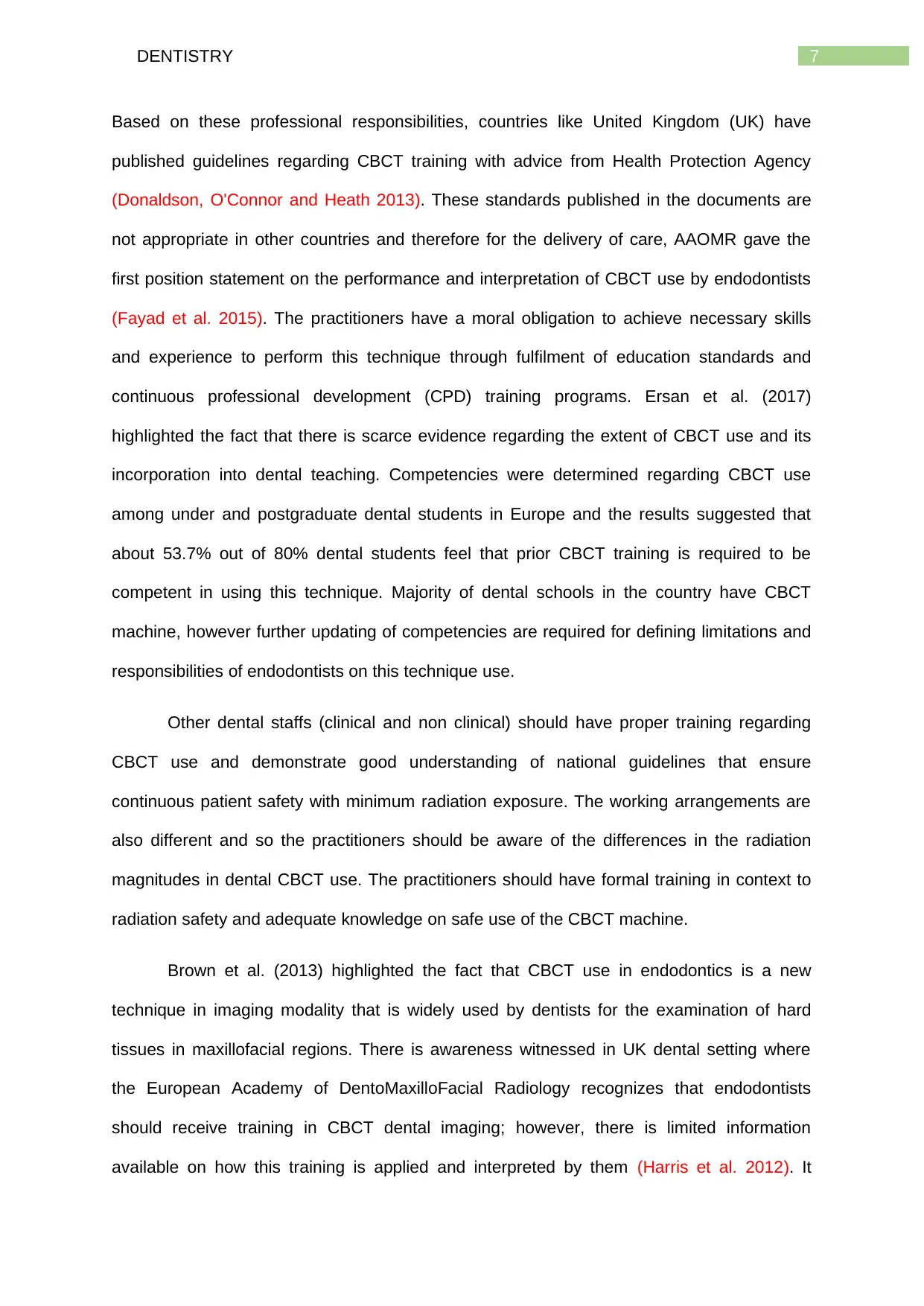
7DENTISTRY
Based on these professional responsibilities, countries like United Kingdom (UK) have
published guidelines regarding CBCT training with advice from Health Protection Agency
(Donaldson, O'Connor and Heath 2013). These standards published in the documents are
not appropriate in other countries and therefore for the delivery of care, AAOMR gave the
first position statement on the performance and interpretation of CBCT use by endodontists
(Fayad et al. 2015). The practitioners have a moral obligation to achieve necessary skills
and experience to perform this technique through fulfilment of education standards and
continuous professional development (CPD) training programs. Ersan et al. (2017)
highlighted the fact that there is scarce evidence regarding the extent of CBCT use and its
incorporation into dental teaching. Competencies were determined regarding CBCT use
among under and postgraduate dental students in Europe and the results suggested that
about 53.7% out of 80% dental students feel that prior CBCT training is required to be
competent in using this technique. Majority of dental schools in the country have CBCT
machine, however further updating of competencies are required for defining limitations and
responsibilities of endodontists on this technique use.
Other dental staffs (clinical and non clinical) should have proper training regarding
CBCT use and demonstrate good understanding of national guidelines that ensure
continuous patient safety with minimum radiation exposure. The working arrangements are
also different and so the practitioners should be aware of the differences in the radiation
magnitudes in dental CBCT use. The practitioners should have formal training in context to
radiation safety and adequate knowledge on safe use of the CBCT machine.
Brown et al. (2013) highlighted the fact that CBCT use in endodontics is a new
technique in imaging modality that is widely used by dentists for the examination of hard
tissues in maxillofacial regions. There is awareness witnessed in UK dental setting where
the European Academy of DentoMaxilloFacial Radiology recognizes that endodontists
should receive training in CBCT dental imaging; however, there is limited information
available on how this training is applied and interpreted by them (Harris et al. 2012). It
Based on these professional responsibilities, countries like United Kingdom (UK) have
published guidelines regarding CBCT training with advice from Health Protection Agency
(Donaldson, O'Connor and Heath 2013). These standards published in the documents are
not appropriate in other countries and therefore for the delivery of care, AAOMR gave the
first position statement on the performance and interpretation of CBCT use by endodontists
(Fayad et al. 2015). The practitioners have a moral obligation to achieve necessary skills
and experience to perform this technique through fulfilment of education standards and
continuous professional development (CPD) training programs. Ersan et al. (2017)
highlighted the fact that there is scarce evidence regarding the extent of CBCT use and its
incorporation into dental teaching. Competencies were determined regarding CBCT use
among under and postgraduate dental students in Europe and the results suggested that
about 53.7% out of 80% dental students feel that prior CBCT training is required to be
competent in using this technique. Majority of dental schools in the country have CBCT
machine, however further updating of competencies are required for defining limitations and
responsibilities of endodontists on this technique use.
Other dental staffs (clinical and non clinical) should have proper training regarding
CBCT use and demonstrate good understanding of national guidelines that ensure
continuous patient safety with minimum radiation exposure. The working arrangements are
also different and so the practitioners should be aware of the differences in the radiation
magnitudes in dental CBCT use. The practitioners should have formal training in context to
radiation safety and adequate knowledge on safe use of the CBCT machine.
Brown et al. (2013) highlighted the fact that CBCT use in endodontics is a new
technique in imaging modality that is widely used by dentists for the examination of hard
tissues in maxillofacial regions. There is awareness witnessed in UK dental setting where
the European Academy of DentoMaxilloFacial Radiology recognizes that endodontists
should receive training in CBCT dental imaging; however, there is limited information
available on how this training is applied and interpreted by them (Harris et al. 2012). It
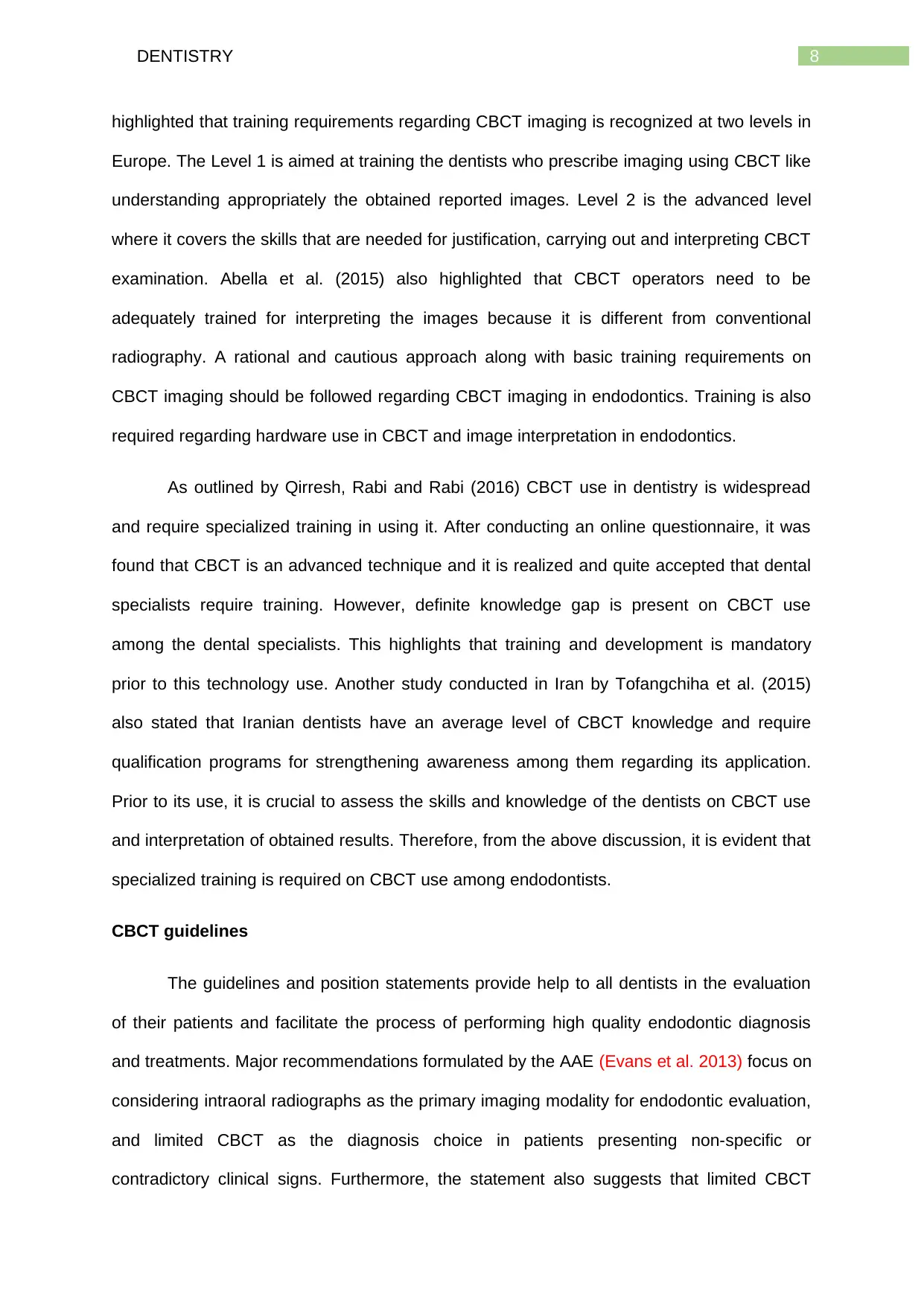
8DENTISTRY
highlighted that training requirements regarding CBCT imaging is recognized at two levels in
Europe. The Level 1 is aimed at training the dentists who prescribe imaging using CBCT like
understanding appropriately the obtained reported images. Level 2 is the advanced level
where it covers the skills that are needed for justification, carrying out and interpreting CBCT
examination. Abella et al. (2015) also highlighted that CBCT operators need to be
adequately trained for interpreting the images because it is different from conventional
radiography. A rational and cautious approach along with basic training requirements on
CBCT imaging should be followed regarding CBCT imaging in endodontics. Training is also
required regarding hardware use in CBCT and image interpretation in endodontics.
As outlined by Qirresh, Rabi and Rabi (2016) CBCT use in dentistry is widespread
and require specialized training in using it. After conducting an online questionnaire, it was
found that CBCT is an advanced technique and it is realized and quite accepted that dental
specialists require training. However, definite knowledge gap is present on CBCT use
among the dental specialists. This highlights that training and development is mandatory
prior to this technology use. Another study conducted in Iran by Tofangchiha et al. (2015)
also stated that Iranian dentists have an average level of CBCT knowledge and require
qualification programs for strengthening awareness among them regarding its application.
Prior to its use, it is crucial to assess the skills and knowledge of the dentists on CBCT use
and interpretation of obtained results. Therefore, from the above discussion, it is evident that
specialized training is required on CBCT use among endodontists.
CBCT guidelines
The guidelines and position statements provide help to all dentists in the evaluation
of their patients and facilitate the process of performing high quality endodontic diagnosis
and treatments. Major recommendations formulated by the AAE (Evans et al. 2013) focus on
considering intraoral radiographs as the primary imaging modality for endodontic evaluation,
and limited CBCT as the diagnosis choice in patients presenting non-specific or
contradictory clinical signs. Furthermore, the statement also suggests that limited CBCT
highlighted that training requirements regarding CBCT imaging is recognized at two levels in
Europe. The Level 1 is aimed at training the dentists who prescribe imaging using CBCT like
understanding appropriately the obtained reported images. Level 2 is the advanced level
where it covers the skills that are needed for justification, carrying out and interpreting CBCT
examination. Abella et al. (2015) also highlighted that CBCT operators need to be
adequately trained for interpreting the images because it is different from conventional
radiography. A rational and cautious approach along with basic training requirements on
CBCT imaging should be followed regarding CBCT imaging in endodontics. Training is also
required regarding hardware use in CBCT and image interpretation in endodontics.
As outlined by Qirresh, Rabi and Rabi (2016) CBCT use in dentistry is widespread
and require specialized training in using it. After conducting an online questionnaire, it was
found that CBCT is an advanced technique and it is realized and quite accepted that dental
specialists require training. However, definite knowledge gap is present on CBCT use
among the dental specialists. This highlights that training and development is mandatory
prior to this technology use. Another study conducted in Iran by Tofangchiha et al. (2015)
also stated that Iranian dentists have an average level of CBCT knowledge and require
qualification programs for strengthening awareness among them regarding its application.
Prior to its use, it is crucial to assess the skills and knowledge of the dentists on CBCT use
and interpretation of obtained results. Therefore, from the above discussion, it is evident that
specialized training is required on CBCT use among endodontists.
CBCT guidelines
The guidelines and position statements provide help to all dentists in the evaluation
of their patients and facilitate the process of performing high quality endodontic diagnosis
and treatments. Major recommendations formulated by the AAE (Evans et al. 2013) focus on
considering intraoral radiographs as the primary imaging modality for endodontic evaluation,
and limited CBCT as the diagnosis choice in patients presenting non-specific or
contradictory clinical signs. Furthermore, the statement also suggests that limited CBCT
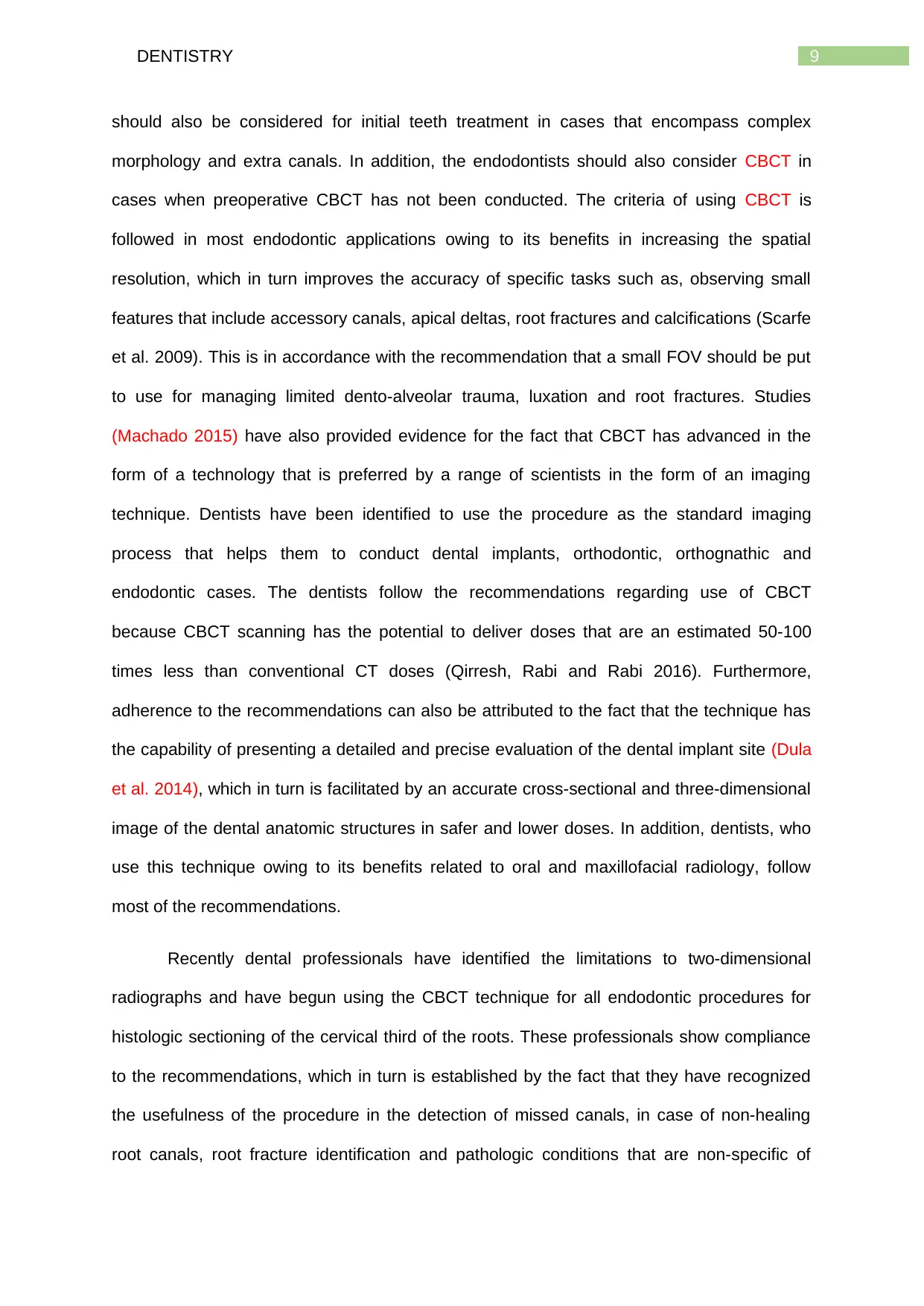
9DENTISTRY
should also be considered for initial teeth treatment in cases that encompass complex
morphology and extra canals. In addition, the endodontists should also consider CBCT in
cases when preoperative CBCT has not been conducted. The criteria of using CBCT is
followed in most endodontic applications owing to its benefits in increasing the spatial
resolution, which in turn improves the accuracy of specific tasks such as, observing small
features that include accessory canals, apical deltas, root fractures and calcifications (Scarfe
et al. 2009). This is in accordance with the recommendation that a small FOV should be put
to use for managing limited dento-alveolar trauma, luxation and root fractures. Studies
(Machado 2015) have also provided evidence for the fact that CBCT has advanced in the
form of a technology that is preferred by a range of scientists in the form of an imaging
technique. Dentists have been identified to use the procedure as the standard imaging
process that helps them to conduct dental implants, orthodontic, orthognathic and
endodontic cases. The dentists follow the recommendations regarding use of CBCT
because CBCT scanning has the potential to deliver doses that are an estimated 50-100
times less than conventional CT doses (Qirresh, Rabi and Rabi 2016). Furthermore,
adherence to the recommendations can also be attributed to the fact that the technique has
the capability of presenting a detailed and precise evaluation of the dental implant site (Dula
et al. 2014), which in turn is facilitated by an accurate cross-sectional and three-dimensional
image of the dental anatomic structures in safer and lower doses. In addition, dentists, who
use this technique owing to its benefits related to oral and maxillofacial radiology, follow
most of the recommendations.
Recently dental professionals have identified the limitations to two-dimensional
radiographs and have begun using the CBCT technique for all endodontic procedures for
histologic sectioning of the cervical third of the roots. These professionals show compliance
to the recommendations, which in turn is established by the fact that they have recognized
the usefulness of the procedure in the detection of missed canals, in case of non-healing
root canals, root fracture identification and pathologic conditions that are non-specific of
should also be considered for initial teeth treatment in cases that encompass complex
morphology and extra canals. In addition, the endodontists should also consider CBCT in
cases when preoperative CBCT has not been conducted. The criteria of using CBCT is
followed in most endodontic applications owing to its benefits in increasing the spatial
resolution, which in turn improves the accuracy of specific tasks such as, observing small
features that include accessory canals, apical deltas, root fractures and calcifications (Scarfe
et al. 2009). This is in accordance with the recommendation that a small FOV should be put
to use for managing limited dento-alveolar trauma, luxation and root fractures. Studies
(Machado 2015) have also provided evidence for the fact that CBCT has advanced in the
form of a technology that is preferred by a range of scientists in the form of an imaging
technique. Dentists have been identified to use the procedure as the standard imaging
process that helps them to conduct dental implants, orthodontic, orthognathic and
endodontic cases. The dentists follow the recommendations regarding use of CBCT
because CBCT scanning has the potential to deliver doses that are an estimated 50-100
times less than conventional CT doses (Qirresh, Rabi and Rabi 2016). Furthermore,
adherence to the recommendations can also be attributed to the fact that the technique has
the capability of presenting a detailed and precise evaluation of the dental implant site (Dula
et al. 2014), which in turn is facilitated by an accurate cross-sectional and three-dimensional
image of the dental anatomic structures in safer and lower doses. In addition, dentists, who
use this technique owing to its benefits related to oral and maxillofacial radiology, follow
most of the recommendations.
Recently dental professionals have identified the limitations to two-dimensional
radiographs and have begun using the CBCT technique for all endodontic procedures for
histologic sectioning of the cervical third of the roots. These professionals show compliance
to the recommendations, which in turn is established by the fact that they have recognized
the usefulness of the procedure in the detection of missed canals, in case of non-healing
root canals, root fracture identification and pathologic conditions that are non-specific of
Secure Best Marks with AI Grader
Need help grading? Try our AI Grader for instant feedback on your assignments.
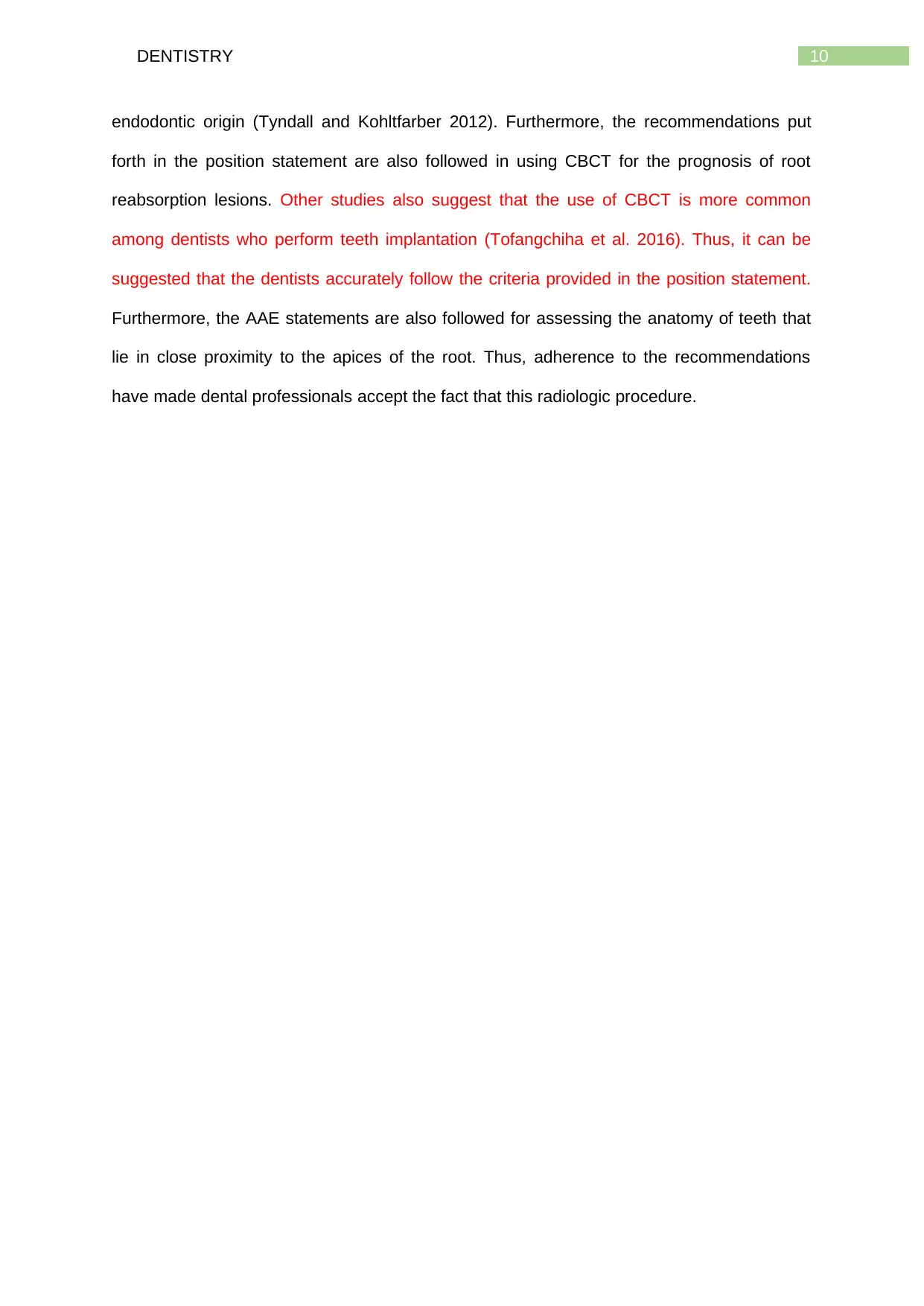
10DENTISTRY
endodontic origin (Tyndall and Kohltfarber 2012). Furthermore, the recommendations put
forth in the position statement are also followed in using CBCT for the prognosis of root
reabsorption lesions. Other studies also suggest that the use of CBCT is more common
among dentists who perform teeth implantation (Tofangchiha et al. 2016). Thus, it can be
suggested that the dentists accurately follow the criteria provided in the position statement.
Furthermore, the AAE statements are also followed for assessing the anatomy of teeth that
lie in close proximity to the apices of the root. Thus, adherence to the recommendations
have made dental professionals accept the fact that this radiologic procedure.
endodontic origin (Tyndall and Kohltfarber 2012). Furthermore, the recommendations put
forth in the position statement are also followed in using CBCT for the prognosis of root
reabsorption lesions. Other studies also suggest that the use of CBCT is more common
among dentists who perform teeth implantation (Tofangchiha et al. 2016). Thus, it can be
suggested that the dentists accurately follow the criteria provided in the position statement.
Furthermore, the AAE statements are also followed for assessing the anatomy of teeth that
lie in close proximity to the apices of the root. Thus, adherence to the recommendations
have made dental professionals accept the fact that this radiologic procedure.

11DENTISTRY
References
Abella, F., Morales, K., Garrido, I., Pascual, J., Duran-Sindreu, F. and Roig, M., 2015.
Endodontic applications of cone beam computed tomography: Case series and literature
review. Giornale Italiano di Endodonzia, 29(2): 38-50.
Ahlowalia, M.S., Patel, S., Anwar, H.M.S., Cama, G., Austin, R.S., Wilson, R. and Mannocci,
F., 2013. Accuracy of CBCT for volumetric measurement of simulated periapical
lesions. International endodontic journal, 46(6): 538-546.
Arnheiter, C., Scarfe, W.C. and Farman, A.G., 2006. Trends in maxillofacial cone-beam
computed tomography usage. Oral Radiology, 22(2): 80-85.
Bornstein, M.M., Scarfe, W.C., Vaughn, V.M. and Jacobs, R., 2014. Cone beam computed
tomography in implant dentistry: a systematic review focusing on guidelines, indications, and
radiation dose risks. International journal of oral & maxillofacial implants, 29.
Brown, J., Jacobs, R., Levring Jäghagen, E., Lindh, C., Baksi, G., Schulze, D. and Schulze,
R., 2013. Basic training requirements for the use of dental CBCT by dentists: a position
paper prepared by the European Academy of DentoMaxilloFacial
Radiology. Dentomaxillofacial Radiology, 43(1), p.20130291.
de Gonzalez, A.B., Gilbert, E., Curtis, R., Inskip, P., Kleinerman, R., Morton, L., Rajaraman,
P. and Little, M.P., 2013. Second solid cancers after radiation therapy: a systematic review
of the epidemiologic studies of the radiation dose-response relationship. International
Journal of Radiation Oncology* Biology* Physics, 86(2):224-233.
Deepak, B.S., Subash, T.S., Narmatha, V.J., Anamika, T., Snehil, T.K. and Nandini, D.B.,
2012. Imaging techniques in endodontics: an overview. Journal of clinical imaging
science, 2.
Donaldson, K., O'Connor, S. and Heath, N., 2013. Dental cone beam CT image quality
possibly reduced by patient movement. Dentomaxillofacial Radiology, 42(2), p.91866873.
References
Abella, F., Morales, K., Garrido, I., Pascual, J., Duran-Sindreu, F. and Roig, M., 2015.
Endodontic applications of cone beam computed tomography: Case series and literature
review. Giornale Italiano di Endodonzia, 29(2): 38-50.
Ahlowalia, M.S., Patel, S., Anwar, H.M.S., Cama, G., Austin, R.S., Wilson, R. and Mannocci,
F., 2013. Accuracy of CBCT for volumetric measurement of simulated periapical
lesions. International endodontic journal, 46(6): 538-546.
Arnheiter, C., Scarfe, W.C. and Farman, A.G., 2006. Trends in maxillofacial cone-beam
computed tomography usage. Oral Radiology, 22(2): 80-85.
Bornstein, M.M., Scarfe, W.C., Vaughn, V.M. and Jacobs, R., 2014. Cone beam computed
tomography in implant dentistry: a systematic review focusing on guidelines, indications, and
radiation dose risks. International journal of oral & maxillofacial implants, 29.
Brown, J., Jacobs, R., Levring Jäghagen, E., Lindh, C., Baksi, G., Schulze, D. and Schulze,
R., 2013. Basic training requirements for the use of dental CBCT by dentists: a position
paper prepared by the European Academy of DentoMaxilloFacial
Radiology. Dentomaxillofacial Radiology, 43(1), p.20130291.
de Gonzalez, A.B., Gilbert, E., Curtis, R., Inskip, P., Kleinerman, R., Morton, L., Rajaraman,
P. and Little, M.P., 2013. Second solid cancers after radiation therapy: a systematic review
of the epidemiologic studies of the radiation dose-response relationship. International
Journal of Radiation Oncology* Biology* Physics, 86(2):224-233.
Deepak, B.S., Subash, T.S., Narmatha, V.J., Anamika, T., Snehil, T.K. and Nandini, D.B.,
2012. Imaging techniques in endodontics: an overview. Journal of clinical imaging
science, 2.
Donaldson, K., O'Connor, S. and Heath, N., 2013. Dental cone beam CT image quality
possibly reduced by patient movement. Dentomaxillofacial Radiology, 42(2), p.91866873.
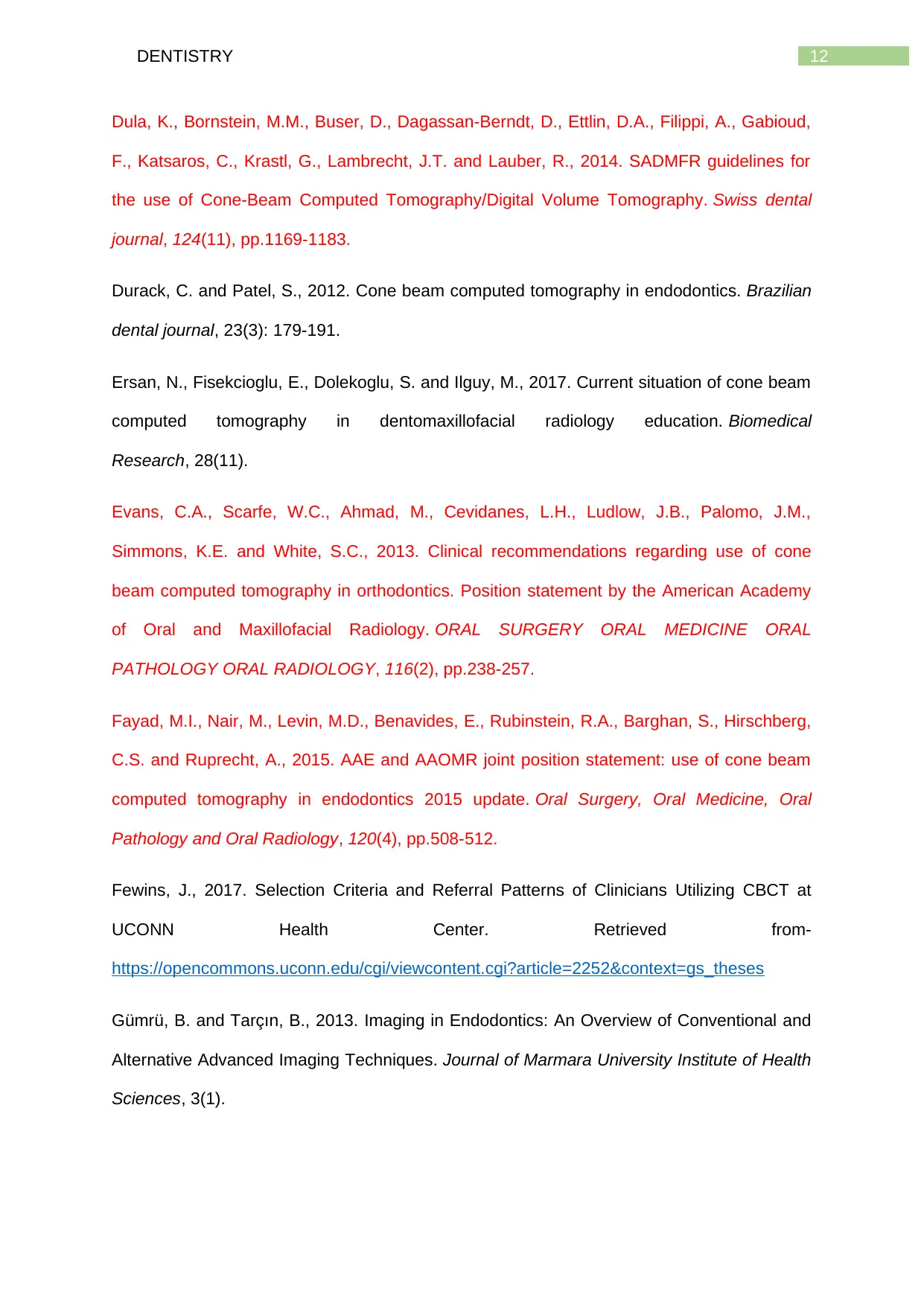
12DENTISTRY
Dula, K., Bornstein, M.M., Buser, D., Dagassan-Berndt, D., Ettlin, D.A., Filippi, A., Gabioud,
F., Katsaros, C., Krastl, G., Lambrecht, J.T. and Lauber, R., 2014. SADMFR guidelines for
the use of Cone-Beam Computed Tomography/Digital Volume Tomography. Swiss dental
journal, 124(11), pp.1169-1183.
Durack, C. and Patel, S., 2012. Cone beam computed tomography in endodontics. Brazilian
dental journal, 23(3): 179-191.
Ersan, N., Fisekcioglu, E., Dolekoglu, S. and Ilguy, M., 2017. Current situation of cone beam
computed tomography in dentomaxillofacial radiology education. Biomedical
Research, 28(11).
Evans, C.A., Scarfe, W.C., Ahmad, M., Cevidanes, L.H., Ludlow, J.B., Palomo, J.M.,
Simmons, K.E. and White, S.C., 2013. Clinical recommendations regarding use of cone
beam computed tomography in orthodontics. Position statement by the American Academy
of Oral and Maxillofacial Radiology. ORAL SURGERY ORAL MEDICINE ORAL
PATHOLOGY ORAL RADIOLOGY, 116(2), pp.238-257.
Fayad, M.I., Nair, M., Levin, M.D., Benavides, E., Rubinstein, R.A., Barghan, S., Hirschberg,
C.S. and Ruprecht, A., 2015. AAE and AAOMR joint position statement: use of cone beam
computed tomography in endodontics 2015 update. Oral Surgery, Oral Medicine, Oral
Pathology and Oral Radiology, 120(4), pp.508-512.
Fewins, J., 2017. Selection Criteria and Referral Patterns of Clinicians Utilizing CBCT at
UCONN Health Center. Retrieved from-
https://opencommons.uconn.edu/cgi/viewcontent.cgi?article=2252&context=gs_theses
Gümrü, B. and Tarçın, B., 2013. Imaging in Endodontics: An Overview of Conventional and
Alternative Advanced Imaging Techniques. Journal of Marmara University Institute of Health
Sciences, 3(1).
Dula, K., Bornstein, M.M., Buser, D., Dagassan-Berndt, D., Ettlin, D.A., Filippi, A., Gabioud,
F., Katsaros, C., Krastl, G., Lambrecht, J.T. and Lauber, R., 2014. SADMFR guidelines for
the use of Cone-Beam Computed Tomography/Digital Volume Tomography. Swiss dental
journal, 124(11), pp.1169-1183.
Durack, C. and Patel, S., 2012. Cone beam computed tomography in endodontics. Brazilian
dental journal, 23(3): 179-191.
Ersan, N., Fisekcioglu, E., Dolekoglu, S. and Ilguy, M., 2017. Current situation of cone beam
computed tomography in dentomaxillofacial radiology education. Biomedical
Research, 28(11).
Evans, C.A., Scarfe, W.C., Ahmad, M., Cevidanes, L.H., Ludlow, J.B., Palomo, J.M.,
Simmons, K.E. and White, S.C., 2013. Clinical recommendations regarding use of cone
beam computed tomography in orthodontics. Position statement by the American Academy
of Oral and Maxillofacial Radiology. ORAL SURGERY ORAL MEDICINE ORAL
PATHOLOGY ORAL RADIOLOGY, 116(2), pp.238-257.
Fayad, M.I., Nair, M., Levin, M.D., Benavides, E., Rubinstein, R.A., Barghan, S., Hirschberg,
C.S. and Ruprecht, A., 2015. AAE and AAOMR joint position statement: use of cone beam
computed tomography in endodontics 2015 update. Oral Surgery, Oral Medicine, Oral
Pathology and Oral Radiology, 120(4), pp.508-512.
Fewins, J., 2017. Selection Criteria and Referral Patterns of Clinicians Utilizing CBCT at
UCONN Health Center. Retrieved from-
https://opencommons.uconn.edu/cgi/viewcontent.cgi?article=2252&context=gs_theses
Gümrü, B. and Tarçın, B., 2013. Imaging in Endodontics: An Overview of Conventional and
Alternative Advanced Imaging Techniques. Journal of Marmara University Institute of Health
Sciences, 3(1).
Paraphrase This Document
Need a fresh take? Get an instant paraphrase of this document with our AI Paraphraser
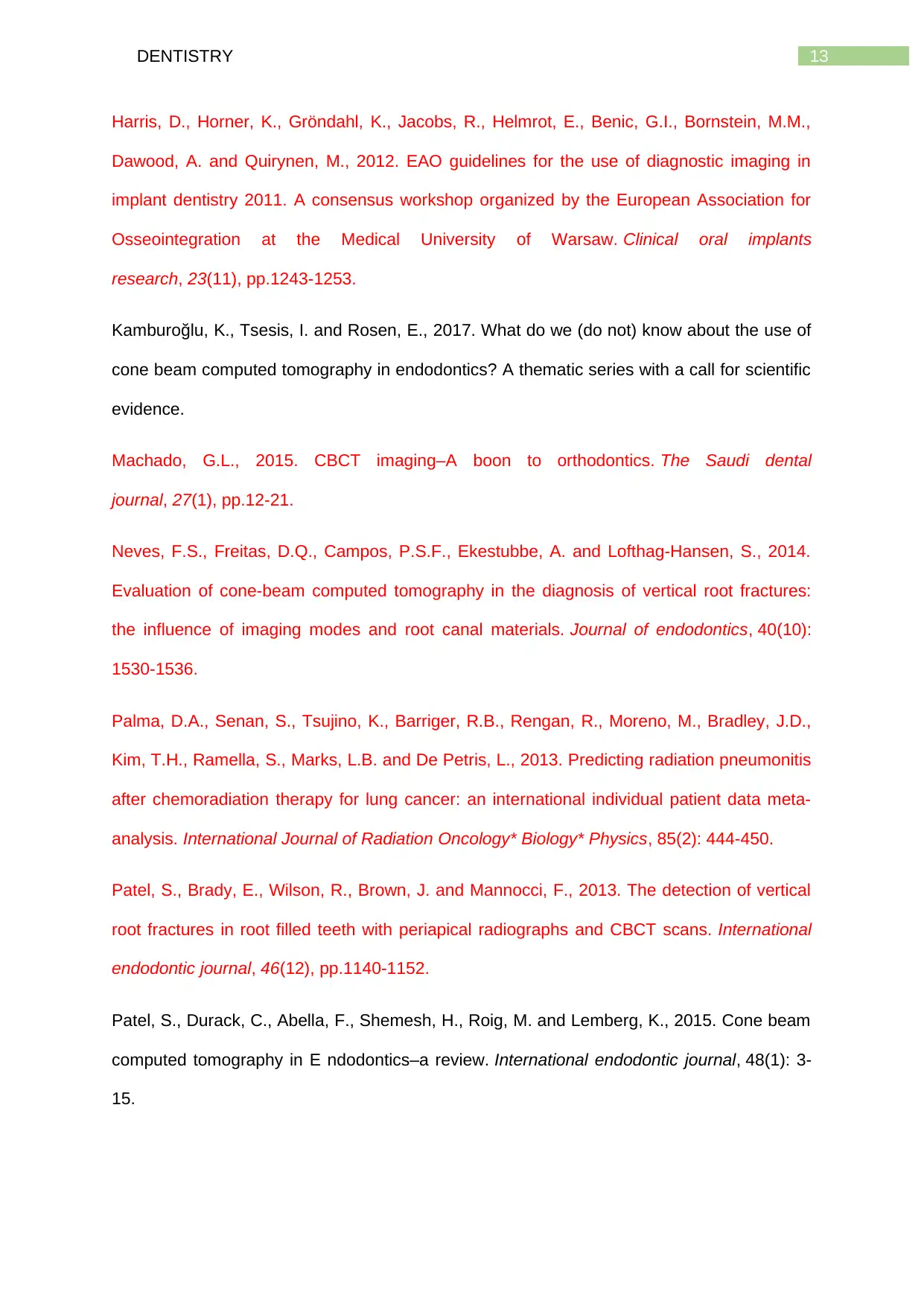
13DENTISTRY
Harris, D., Horner, K., Gröndahl, K., Jacobs, R., Helmrot, E., Benic, G.I., Bornstein, M.M.,
Dawood, A. and Quirynen, M., 2012. EAO guidelines for the use of diagnostic imaging in
implant dentistry 2011. A consensus workshop organized by the European Association for
Osseointegration at the Medical University of Warsaw. Clinical oral implants
research, 23(11), pp.1243-1253.
Kamburoğlu, K., Tsesis, I. and Rosen, E., 2017. What do we (do not) know about the use of
cone beam computed tomography in endodontics? A thematic series with a call for scientific
evidence.
Machado, G.L., 2015. CBCT imaging–A boon to orthodontics. The Saudi dental
journal, 27(1), pp.12-21.
Neves, F.S., Freitas, D.Q., Campos, P.S.F., Ekestubbe, A. and Lofthag-Hansen, S., 2014.
Evaluation of cone-beam computed tomography in the diagnosis of vertical root fractures:
the influence of imaging modes and root canal materials. Journal of endodontics, 40(10):
1530-1536.
Palma, D.A., Senan, S., Tsujino, K., Barriger, R.B., Rengan, R., Moreno, M., Bradley, J.D.,
Kim, T.H., Ramella, S., Marks, L.B. and De Petris, L., 2013. Predicting radiation pneumonitis
after chemoradiation therapy for lung cancer: an international individual patient data meta-
analysis. International Journal of Radiation Oncology* Biology* Physics, 85(2): 444-450.
Patel, S., Brady, E., Wilson, R., Brown, J. and Mannocci, F., 2013. The detection of vertical
root fractures in root filled teeth with periapical radiographs and CBCT scans. International
endodontic journal, 46(12), pp.1140-1152.
Patel, S., Durack, C., Abella, F., Shemesh, H., Roig, M. and Lemberg, K., 2015. Cone beam
computed tomography in E ndodontics–a review. International endodontic journal, 48(1): 3-
15.
Harris, D., Horner, K., Gröndahl, K., Jacobs, R., Helmrot, E., Benic, G.I., Bornstein, M.M.,
Dawood, A. and Quirynen, M., 2012. EAO guidelines for the use of diagnostic imaging in
implant dentistry 2011. A consensus workshop organized by the European Association for
Osseointegration at the Medical University of Warsaw. Clinical oral implants
research, 23(11), pp.1243-1253.
Kamburoğlu, K., Tsesis, I. and Rosen, E., 2017. What do we (do not) know about the use of
cone beam computed tomography in endodontics? A thematic series with a call for scientific
evidence.
Machado, G.L., 2015. CBCT imaging–A boon to orthodontics. The Saudi dental
journal, 27(1), pp.12-21.
Neves, F.S., Freitas, D.Q., Campos, P.S.F., Ekestubbe, A. and Lofthag-Hansen, S., 2014.
Evaluation of cone-beam computed tomography in the diagnosis of vertical root fractures:
the influence of imaging modes and root canal materials. Journal of endodontics, 40(10):
1530-1536.
Palma, D.A., Senan, S., Tsujino, K., Barriger, R.B., Rengan, R., Moreno, M., Bradley, J.D.,
Kim, T.H., Ramella, S., Marks, L.B. and De Petris, L., 2013. Predicting radiation pneumonitis
after chemoradiation therapy for lung cancer: an international individual patient data meta-
analysis. International Journal of Radiation Oncology* Biology* Physics, 85(2): 444-450.
Patel, S., Brady, E., Wilson, R., Brown, J. and Mannocci, F., 2013. The detection of vertical
root fractures in root filled teeth with periapical radiographs and CBCT scans. International
endodontic journal, 46(12), pp.1140-1152.
Patel, S., Durack, C., Abella, F., Shemesh, H., Roig, M. and Lemberg, K., 2015. Cone beam
computed tomography in E ndodontics–a review. International endodontic journal, 48(1): 3-
15.

14DENTISTRY
Paul, J., Mbalisike, E.C. and Vogl, T.J., 2013. Radiation dose to procedural personnel and
patients from an X-ray volume imaging system. European radiology, 23(12): 3262-3270.
Pertl, L., Gashi-Cenkoglu, B., Reichmann, J., Jakse, N. and Pertl, C., 2013. Preoperative
assessment of the mandibular canal in implant surgery: comparison of rotational panoramic
radiography (OPG), computed tomography (CT) and cone beam computed tomography
(CBCT) for preoperative assessment in implant surgery. European journal of oral
implantology, 6(1).
Qirresh, E., Rabi, H. and Rabi, T., 2016. Current status of awareness, knowledge and
attitude of dentists in palestine towards cone beam computed tomography: A survey. Oral
Biology and Dentistry, 4(1): 1.
Rawson, J.V., 2015. CBCT: Wide Range of Clinical Applications and Wide Range of
Doses. Annals of the ICRP, 44(1): 7.
Rehani, M.M., Gupta, R., Bartling, S., Sharp, G.C., Pauwels, R., Berris, T. and Boone, J.M.,
2015. ICRP publication 129: radiological protection in cone beam computed tomography
(CBCT).
Scarfe, W.C., Levin, M.D., Gane, D. and Farman, A.G., 2009. Use of cone beam computed
tomography in endodontics. International journal of dentistry, 111(2): 234-237.
SEDENTEX CT., 2011. Radiation Protection: Cone Beam Ct For Dental And Maxillofacial
Radiology. Retrieved from- http://www.sedentexct.eu/files/guidelines_final.pdf
Tofangchiha, M., Arianfar, F., Bakhshi, M. and Khorasani, M., 2015. The assessment of
dentists’ knowledge regarding indications of cone beam computed tomography in Qazvin,
Iran. Biotechnology and health sciences, 2(1): e25815.
Tyndall, D.A. and Kohltfarber, H., 2012. Application of cone beam volumetric tomography in
endodontics. Australian dental journal, 57: 72-81.
Paul, J., Mbalisike, E.C. and Vogl, T.J., 2013. Radiation dose to procedural personnel and
patients from an X-ray volume imaging system. European radiology, 23(12): 3262-3270.
Pertl, L., Gashi-Cenkoglu, B., Reichmann, J., Jakse, N. and Pertl, C., 2013. Preoperative
assessment of the mandibular canal in implant surgery: comparison of rotational panoramic
radiography (OPG), computed tomography (CT) and cone beam computed tomography
(CBCT) for preoperative assessment in implant surgery. European journal of oral
implantology, 6(1).
Qirresh, E., Rabi, H. and Rabi, T., 2016. Current status of awareness, knowledge and
attitude of dentists in palestine towards cone beam computed tomography: A survey. Oral
Biology and Dentistry, 4(1): 1.
Rawson, J.V., 2015. CBCT: Wide Range of Clinical Applications and Wide Range of
Doses. Annals of the ICRP, 44(1): 7.
Rehani, M.M., Gupta, R., Bartling, S., Sharp, G.C., Pauwels, R., Berris, T. and Boone, J.M.,
2015. ICRP publication 129: radiological protection in cone beam computed tomography
(CBCT).
Scarfe, W.C., Levin, M.D., Gane, D. and Farman, A.G., 2009. Use of cone beam computed
tomography in endodontics. International journal of dentistry, 111(2): 234-237.
SEDENTEX CT., 2011. Radiation Protection: Cone Beam Ct For Dental And Maxillofacial
Radiology. Retrieved from- http://www.sedentexct.eu/files/guidelines_final.pdf
Tofangchiha, M., Arianfar, F., Bakhshi, M. and Khorasani, M., 2015. The assessment of
dentists’ knowledge regarding indications of cone beam computed tomography in Qazvin,
Iran. Biotechnology and health sciences, 2(1): e25815.
Tyndall, D.A. and Kohltfarber, H., 2012. Application of cone beam volumetric tomography in
endodontics. Australian dental journal, 57: 72-81.

15DENTISTRY
Warhekar, S., Nagarajappa, S., Dasar, P.L., Warhekar, A.M., Parihar, A., Phulambrikar, T.,
Airen, B. and Jain, D., 2015. Incidental findings on cone beam computed tomography and
reasons for referral by dental practitioners in indore city (mp). Journal of clinical and
diagnostic research: JCDR, 9(2): ZC21.
Warhekar, S., Nagarajappa, S., Dasar, P.L., Warhekar, A.M., Parihar, A., Phulambrikar, T.,
Airen, B. and Jain, D., 2015. Incidental findings on cone beam computed tomography and
reasons for referral by dental practitioners in indore city (mp). Journal of clinical and
diagnostic research: JCDR, 9(2): ZC21.
1 out of 16
Related Documents
Your All-in-One AI-Powered Toolkit for Academic Success.
+13062052269
info@desklib.com
Available 24*7 on WhatsApp / Email
![[object Object]](/_next/static/media/star-bottom.7253800d.svg)
Unlock your academic potential
© 2024 | Zucol Services PVT LTD | All rights reserved.




